Wonderful Whitby
Whitby's East Side
The East Side of Whitby is the by far the oldest of the two sides. Whitby Abbey, built from 657 AD was the founding point for the town, and on the headland near the Abbey there are indications of a small settlement. Leading down the 199 steps from the Abbey to Church Street (formerly Kirkgate AD 1318) there are cobbled streets and many cottages with houses dating from the 1600’s. Houses have even been documented at the foot of the 199 steps as early as 1370! The Abbey itself, is accessible on foot from Church Street, via the 199 Steps or the steep cobbled Donkey Path, shown on the photo.

Whitby Market Place
Whitby Market Place, dating back to 1640, with the Town Hall dating from 1788 built by Nathaniel Cholmley, is a lively place with markets held on a Tuesday, Saturday and Sunday. There is a Farmer’s market on a Thursday (please check days as there is a variation throughout the year). The old cobbled streets stretch from the bottom of the Abbey Steps along Church Street, Sandgate and to the north along Henrietta Street.
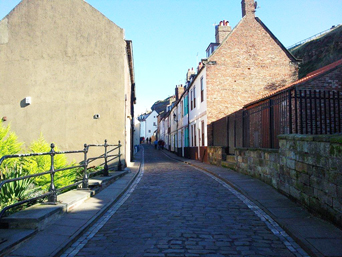
Henrietta Street
Henrietta Street, (named after Henrietta Cholmley) is only a short street in relation to its former glory in 1787, when upward of 1,000 residents lived there. A landslip in 1787, and a succession of further landslips have led to its present length. At the northern end of the street is Fortune's Kipper House dating from 1872, founded by William Fortune. The kippers are smoked over oak and beech fires to give their distinctive taste and colour. Many of the cottages on Henrietta Street are now holiday lets, but a number of local Whitby people are still resident.
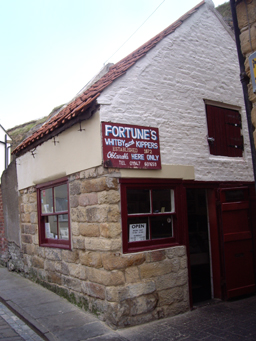
Fortune's Kippers on Henrietta Street
Whitby's East Side is a great place to find a huge variety of interesting Whitby Shops. Around the Market Place, there are a number of shops and cafes. The Shambles, the old Burberrys Factory, is a public house with an indoor market underneath, selling a mixture of clothing and arts and crafts. Here too are the public conveniences. Alongside the Shambles, is the access to the Whitby Friendship Amateur Rowing Club. The Fishermans Amateur Rowing Club can be accessed here also at low tide.
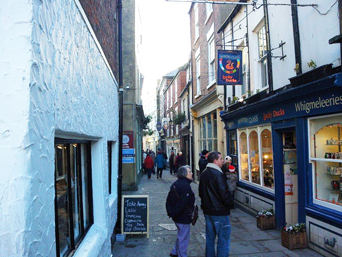
Sandgate Shopping
Leading off the Market Place is Sandgate, so called because it leads to and borders on the east sands. Sandgate is a vibrant and bustling narrow street, with a wide variety of shops, including Whitby Jet jewellery shops, a fresh seafood shop, an olde English sweet shop, a café, a bakery and photographers. Probably the most popular souvenior that visitors to Whitby take home with them is an item of Whitby Jet Jewellery.
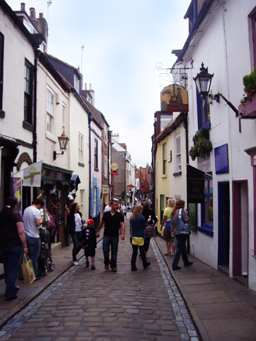
The Top of Church Street
Whitby Jet, made fashionable by Queen Victoria, who wore it in mourning of her beloved Prince Albert (died 1861) has been carved since the bronze age. It is formed by fossilized monkey puzzle trees. There are many seams of the natural jet along the shores of this coast and also inland as far as the Cleveland Hills. In its raw state it is more than likely to be a dull brown, but with polishing it becomes the rich highly polished stone that we all recognise. An exhibition of the Victorian carved jet can be found in the museum in Pannett Park. The Whitby Jet Heritage Centre, at the end of Church Street, has a workshop which was found sealed in an old house in Whitby and removed and rehoused.
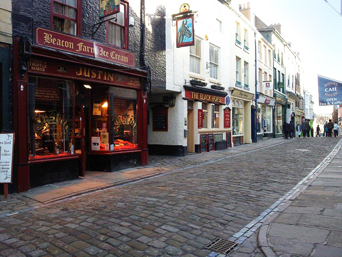
Church Street
Church Street has an amazing number of alleyways and yards which, in the past, provided escape routes from the customs men and press gangs in times gone by. Look at the strange names as you pass by!! Leading off from the yards and alleyways, are a huge number of old fishing cottages, many of which are now self catering accommodation. The cottages nestle into the steep hillside, and are connected by a network of pathways and steep steps. Nowadays the yards house a number of shops, restaurants and craftware places. The old Wesley Hall is now home to a wool and craft shop.
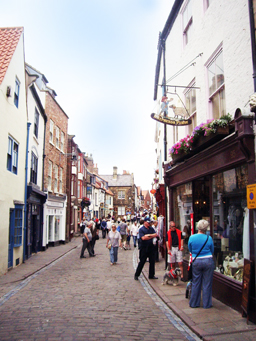
Church Street
Steeped in history, Church Street is very popular with tourists and hence the number of cafes, restaurants and gift shops, including more Whitby Jet Jewellers. The Whitby Book shop has a huge selection of books and a unique wooden spiral staircase. There are also a large number of public houses, and those at the top of the street have some lovely views of the harbour. Further along Church Street, south of the cobbled street, leading to Spital Bridge is the old Whitby Seamans Hospital built in 1676, now converted to housing. Along here too was the Leper Hospital built in 1109, of which there are no remains.
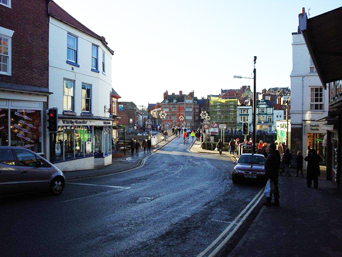
Bridge Street
Bridge Street is reached via the swing bridge and connects to Sandgate and Church Street. Bridge Street is the home to the Whitby Gazette Offices and other businesses including a toy shop, health food shop, cafes and gift shop.
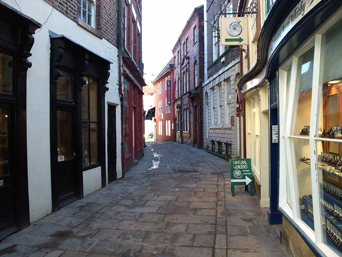
Grape Lane
Grape Lane, also leading off Bridge Street is perhaps one of the most aged streets. In 1595, there were houses on both sides of the narrow street, and it existed even before the dissolution of the Abbey. Along here is the Captain Cook Museum, cafes, Whitby Jet Jewellery shops, bookshops, antiques and a childen's clothing shop.
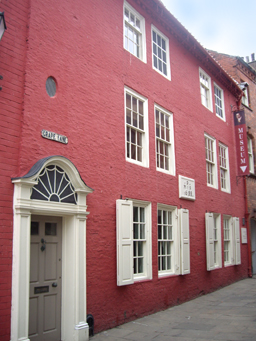
Captain Cook Memorial Museum
The Captain Cook Memorial Museum is housed in the 17th Century house, where the young James Cook
lodged as an apprentice. The website gives details of opening times and admission prices, you can reach it by clicking the following link.
Captain Cook Memorial Museum
